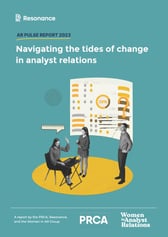
In my last blog I took a look at demystifying analyst relations (AR). It is no longer the dark art it used to be portrayed as and like many other marketing activities, it requires nurturing and a long-term focus for success. The most astute companies understand that AR can help company growth.
While many companies understand the benefits of a long-term strategy, AR programmes can be at odds with quarterly driven sales strategies. When reviewing analyst relations with senior executives, there is one universal question you need to answer: how do I measure and prove my AR programmes’ success?
One way of doing this is the phenomenon of the top right: the leader section in the Forrester Wave, Everest PEAK Matrix and Gartner Magic Quadrant. Some companies have pinned their AR strategy success to the top right alone. In all the years I have worked with global organisations, I would say that in the last ten the top right has become even more pertinent. So with that in mind, below are some key components of success to get your organisation to that top right.
The tick list to success
- Understanding your business - It is important to understand what the business goals of your organisation are and what the company is trying to achieve in the short, medium and long term.
- Identify the right analysts who author the reports – whether that be regional, global or local
- Tier the analysts – which reports are the most relevant to meet your objectives
- Keep informed of the major reports to participate e.g. Forrester Wave, Gartner Magic Quadrant, Everest PEAK Matrix – make friends with the relevant account managers / firms!
- Set expectations – it may take several attempts (approx 2-4 years) to become a leader
- Make sure you have senior executive buy-in from the absolute start of the process
- Qualification process – does your organisation actually meet the participation criteria? If not a majority of them, is there any point participating?
- Allocate people for the various tasks and make sure they stick to them (set up a RACI) – more often than not, a significant amount of information is required to participate in these reports, so make sure the people know what their responsibilities are (and do them!)
- Present the right information in the correct format to analysts – how you speak internally may not be the same to the industry at large. Know the report language, and analysts language inside out.
- Management of briefing schedule – make sure you have the right stakeholders presenting when it comes to the formal vendor briefing
- Rehearse, rehearse and then rehearse again – make sure your spokespeople and your content meet the analyst’s requirements and can be said in 50 minutes for the one-hour vendor briefing (you always want time for questions)
- Feedback – once the report is out and whether or not you’re a leader it is always important to understand how you need to maintain that status, or what good looks like
Need more help in reaching the top right?
These are just some of the components to success, because as previously mentioned, this is about the long game; building strong and trusted relationships with analysts and taking them on your organisation’s journey with you. Here at Resonance, we know the effort and commitment needed to get to the top right and have senior experts that have enabled organisations to achieve their goals.
If you would like to know more about gaining the keys to your own organisation’s success, then feel free to send me an email (Nadia@ResonanceCrowd.com) or give me a call on +44 (0) 208 819 3170.



 "The intricacies of the data-driven landscape is written into the DNA of Resonance. We are built for the data economy."
"The intricacies of the data-driven landscape is written into the DNA of Resonance. We are built for the data economy.".jpeg?width=250&height=181&name=AdobeStock_565367297%20(1).jpeg)
 "In Tech PR we have a front row seat to the changing technology landscape. From Generative AI to Quantum, it's our job to insert our clients' voices into the narrative"
"In Tech PR we have a front row seat to the changing technology landscape. From Generative AI to Quantum, it's our job to insert our clients' voices into the narrative"



 "In a world where the only constant is change, how do tech brands stay one step ahead of the market? That's where Resonance comes in"
"In a world where the only constant is change, how do tech brands stay one step ahead of the market? That's where Resonance comes in".png?width=219&height=219&name=Seb%20Moss%20wavelength%20thumbnail%20(1).png)

 "Resonance is a group of technology, business and communications experts"
"Resonance is a group of technology, business and communications experts"


 Nadia Nizar
Nadia Nizar